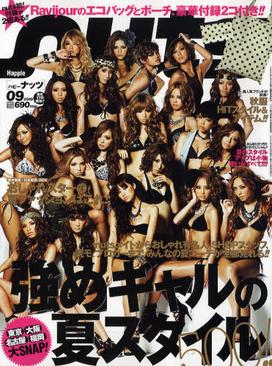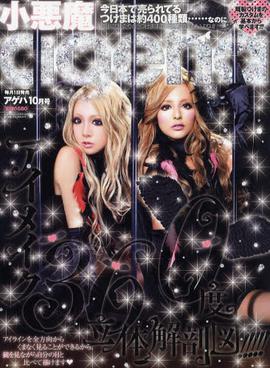Kogal is a Japanese fashion culture that involves girls wearing an outfit based on Japanese school uniforms. The girls may also wear loose socks and scarves, and have dyed hair. The word kogal is anglicized from kogyaru, a contraction of kōkōsei gyaru.

Hisako Sasaki is a Japanese retired professional wrestler better known as Akira Hokuto.

Gyarupronounced [ɡʲa̠ꜜɾɯ̟ᵝ], is a Japanese fashion subculture. The term gyaru is a Japanese transliteration of the English slang word gal.

Egg was a style magazine for gyaru fashion, distributed in Japan. It featured photos of ganguro girls and synopses of their tastes and popular trends. The magazine also usually had photos of the newest fashions, where to buy them, latest hairstyles, cell phones, and make up tips. It also had candid photos of ganguro girls on the streets of Japan, similar to Fruits magazine. Egg had its own models which starred in every magazine. Due to the decline of Gyaru popularity, the magazine shut down with the last issue on 31 May 2014.

Gyaruo are a sub-group of modern Japanese youth culture. They are the male equivalent of the gyaru. The o suffix that is added to the word, is one reading of the kanji for male (男). And recently, the kanji for 'dirty' in Japanese (汚), which also has the same reading, is often used by gyaru and gyaruo in a light hearted way, poking fun at themselves because of the reputation that their subculture has gained within society due to their dark skin, hairstyles and often gritty, rough style of clothing that they wear. Gyaruo are characterised by their deep tans, dyed hair, party lifestyle and a liking for all different types of trance music including para-para dancing music, Eurobeat, etc.
Ayana Tsubaki is a Japanese TV personality and fashion model.

V.B.Rose is a Japanese manga written and illustrated by Banri Hidaka. The manga was serialized in Hakusensha's shōjo magazine, Hana to Yume from February 20, 2004 to February 20, 2009, ending at 83 chapters. The individual chapters were published into 14 bound volumes by Hakusensha from August 19, 2004 to May 19, 2009. The manga is licensed in North America by Tokyopop, and in Italy by Jpop.

"Koakuma Heaven" is the thirty-first single by Japanese musical artist Gackt, released on June 10, 2009. This single was the first of four singles of the countdown to Gackt's 10th anniversary as a solo artist. This single was titled The 1st Heaven. Each of the countdown singles were scheduled to be released within a week of each other.
Hiromi Shinhata, better known simply as Hiromi, is a Japanese fashion model who has been active in the professional and commercial modeling fields since late 2000s. Formerly a popular model for the Egg magazine, she is known for her androgynous looks and is particularly known in the gal scene.
Wei Son is a Japanese fashion model who has been active in both the professional and commercial modeling fields since the late 2000s. She is particularly known in the gyaru scene, as a former major contributor to the Popteen magazine and an exclusive model for its sister magazine PopSister. There are several different ways of spelling her name in Roman script, including Ii Son, Wei Sun, and Wei Son.

Happie Nuts was a gal fashion magazine published monthly in Japan by Inforest Publishing. Targeted at women in their late teens and early 20s, Happie Nuts was highly oriented toward the style of oneh-gal and dark-skin. Based in Tokyo, it was in circulation between 2004 and 2016.

Koakuma Ageha is a gyaru fashion and lifestyle magazine published monthly in Japan. Targeted at females in their late teens and 20s, Koakuma Ageha caters to the styles of Agejo and hime-gyaru. It also incorporates different styles into the agejo style

Arisa Ishikawa, better known by her stage name Sumire (純恋), was a Japanese cabaret hostess and fashion model, who was known as a featured model on the popular gyaru fashion magazine Koakuma Ageha.
Nicole Abe is a Japanese gyaru fashion model who has been featured in Ranzuki (2008–2011) and Happie Nuts gyaru fashion magazines. Abe was once a contributor to Ranzuki.
Hozumi Numajiri, better known as Hozunyam, is a Japanese gyaru fashion model. A hostess living in Tokyo, she is best known for appearing in the Koakuma Ageha fashion magazine and, since her 2010 debut in the magazine, has been well known for her real personal story of a romance with her ex-boyfriend, Bara (バラ), an American motorcycle gang leader.
Megu Fujigamori is a Japanese cabaret hostess, and fashion model best known for appearing in the Koakuma Ageha cabaret-gyaru fashion magazine. A hostess living in Kyoto with genji name "Alice Serisawa", she has regularly appeared in Koakuma Ageha as one of its main models since 2011, and in the magazine, she is commonly referred to by her nickname "Fujimegu" (藤めぐ).
Sayo Hayakawa is a Japanese fashion model. She is best known for her stint as a main model for the Koakuma Ageha cabaret-gyaru fashion magazine.
Sayaka Araki is a Japanese fashion model, disc jockey, and businesswoman. She is best known for her stint as a model for the Koakuma Ageha cabaret-gyaru fashion magazine. She was a major contributor to Koakuma Ageha for 4 years and 10 months, since the magazine's very early days. She left Koakuma Ageha in 2011, and has since become a main model for its sister magazine Ane Ageha.
Sayoko Ozaki is a Japanese fashion model. In the past she belonged to the agency Starray Production, and is currently a free agent. She is mainly known as featuring in the magazine Happie Nuts.










